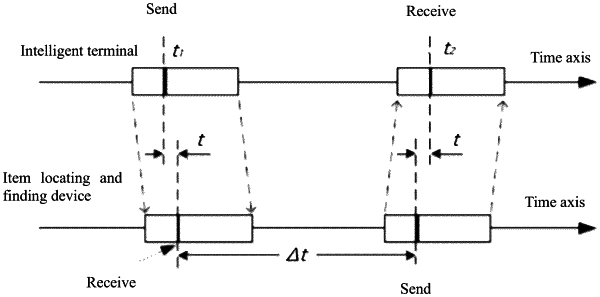| CPC G01S 15/42 (2013.01) [G01S 5/18 (2013.01); G01S 7/52026 (2013.01)] | 1 Claim |

|
1. An item locating and finding method based on an acoustic signal, comprising following steps:
step 1, designing a specific acoustic signal that is expressed as:
 wherein A(t) is an amplitude of a sound wave, T is a period of a Chirp signal, and f0 and fe are an initial frequency and a cut-off frequency respectively;
a received signal is:
 wherein h(t) is a continuous expression of impulse response (CIR) of an indoor acoustic channel ∝i, τi and Ni(t) are a channel fading coefficient, a propagation delay and a random noise of an i-th propagation path;
step 2, performing unilateral and bidirectional ranging based on the acoustic signal;
wherein an intelligent terminal broadcasts an acoustic Chirp signal using a first loudspeaker of the intelligent terminal, and records a current system time t1, after receiving the acoustic Chirp signal by an item locating and finding device installed on a to-be-searched object using a second microphone of the item locating and finding device, the item locating and finding device returns, using a second loudspeaker of the item locating and finding device a Chirp signal after delaying a fixed period of time treply; the intelligent terminal receives a returned Chirp signal using a first microphone of the intelligent terminal; and the intelligent terminal records a current system time t2; an inertial sensor of the intelligent terminal is used for determining a movement track of the intelligent terminal;
a flight time (t) of a signal between the intelligent terminal and the item locating and finding device is:
t=[(t2−t1)−treply]/2
a distance (L) between the intelligent terminal and the item locating and finding device is calculated based on the flight time (t):
L=vsound·t
wherein the vsound is a sound velocity;
step 3, locating based on acoustic ranging and pedestrian dead reckoning (PDR) comprises following steps:
step a, data is preprocessed;
wherein a time required to complete a two-way ranging in dynamic mode, a position of the intelligent terminal changes, two time stamps recorded on the intelligent terminal are not in a same position, interpolation is used to a middle of two positions when the two time stamps recorded on the intelligent terminal are not in the same position;
a hypothesis test with significance level a of about 0.05 is conducted to determine whether ranging results are reliable;
step b, local least square method improves a particle filter
wherein a time series-based window is used to obtain qualified local data of a constrained nonlinear least square method to estimate a reference position of the item locating and finding device, wherein the reference position (Xtag, Ŷtag) acts as a center of a Gaussian distribution of random n particles
 initialized or added to a filter; the filter starts to work after generating particles; wherein the item locating and finding device is considered to be stationary, the position of the intelligent terminal changes in real time; a state model of the particle filter is expressed as:
xit=xit−1
a ranging information L is an observed value, a single observation model is expressed as:
 wherein, h is calculated as a distance between an i-th particle and the position of the intelligent terminal;
when a total number of particles exceeds a threshold Nthreshold refuse particles with low weights are rejected; state estimates are obtained from an approximate posterior probability distribution, is:
 wherein wit′ is a standardization of wit;
step c, a K-means method to identify mirror points
when a short time trajectory approximates a straight line, both an estimated position and a mirror point obtained by a least square method may be a global optimal solution, therefore, another mirror particle filtering algorithm is constructed for estimating a position, including two locally optimal solutions (X1, Y1) within mirror points, (X2, Y2) is solved by the local least square method; where one of the two locally optimal solutions (X1, Y1) is the mirror point; in the initialization stage, N particles
 and N particles
 are generated by a Gaussian distribution; the N particles are centered around (X1, Y1) and (X2, Y2), a weight of each particle is set to ½N; the filter has a same status and observation updates as described in Step b; after each particle update, a K-means algorithm with cluster number set to 2, assigns all particles to their nearest cluster;
if a total weight of particles in cluster 1wtotal_C1 is much less than the total weight of cluster 2wtotal_C2;
 cluster 1 is considered to be the mirror point, and particles corresponds to the mirror point are eliminated; add remaining particles from step b to a global particle filter.
|